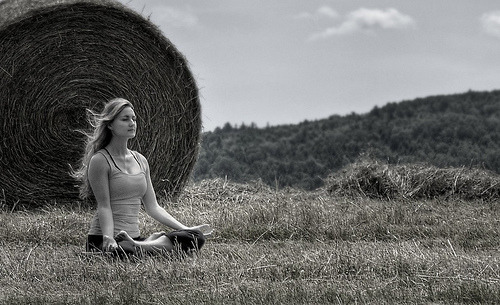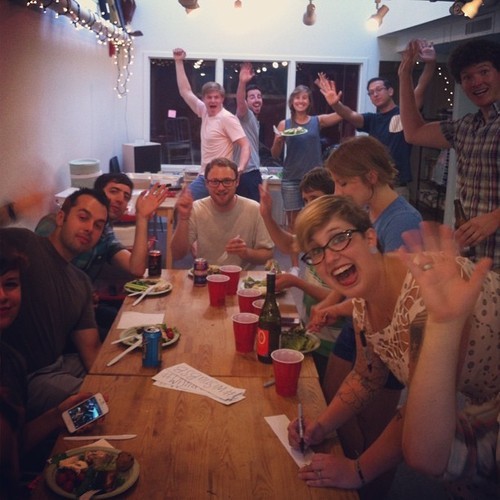
Work is a social thing. It’s done with people, and at the very least, for people. At the same time, you are one person with a job to do. When those personal and social gears are out of alignment, when you’re not connecting with the people you spend so many hours a day with, you get lonely.
Loneliness seems like such an intensely personal, private problem, but it’s much more than that. Loneliness and isolation is a collective issue. And at work, loneliness is yet another effect of the inadequate attention paid to the human side of getting stuff done together.
Whether it’s the inertia of interacting with the same people every day in a way that’s unique from all your other relationships, there’s a prevailing sense that work is this realm where you just deal, that it’s not something that you can improve. While we understand the prioritization of personal friends and loved ones, we often miss out on meaningful interaction with the person down the hall, focus on growing our supposed professional network more than we look next to us to grow higher quality connections.
That kind of thinking is unhealthy, unhelpful, and unproductive.
The quality of your social connections impact your physical and emotional well-being, and so impact the physical and emotional well-being of the people who run a business. Cultivating higher quality relationships with your co-workers, then, requires something of a 360-degree approach, taking responsibility for how you interact with others and how you treat yourself.
The Cheese Who Stands Alone Gets Less Done
When you start feeling isolated at work, you also get demoralized and detached, perhaps even depressed.

In the first study to empirically analyze the effect of loneliness on work performance, Sigal Barsade and Hakan Ozcelik examined the experiences of 672 employees in 143 teams. They found that indeed loneliness led to withdrawal from work, weaker productivity, motivation, and performance. Importantly, the study also showed that this doesn’t happen in a vacuum, that “co-workers can recognize this loneliness and see it hindering team member effectiveness.”
Loneliness is a personal emotion, but it’s not a private concern. The effect of loneliness reverberates, becoming a concern for the group, the organization, the community.
In The Progress Principle, Teresa Amabile and Steven Kramer write about one of the vital ingredients of what makes us fulfilled and flourish in our work — the nourishment factor of human connection. Recognition and gratitude, encouragement, emotional support, and camaraderie are all elements of the nourishment factor — aspects of work that so often are treated as mere window dressing, as spiritless exercises or tired, meaningless buzzwords, and as far as you can get from true priorities.
“Attention is the rarest and purest form of generosity,” French philosopher Simone Weil once wrote, and in what seems to be an ever-head-down, busily streaming life, that seems a harder truth than ever. Your wholehearted attention is how you connect to others, to the world around you, while our pragmatic attitudes about work have little room to even consider generosity.
The nourishment factor — these acts of generosity, of giving and receiving our full attention, expressing gratitude and providing support — feeds our cores, makes us more resilient and enduring, helps us to strive.
Start By Getting Better Control Over Your Feelings
How you pay attention, be present in the moment, and not let feelings like loneliness and stress dominate your thought processes — especially when you’re dealing with that disconnection all by yourself — is the practice of mindfulness.
You may have heard this term before, but if you haven’t embraced it yet, it’s time to check out “mindfulness.”
Patricia Karpas, host of not only the mindfulness podcast “Untangle” but also part founder of the “Meditation Studio” app, explained to Forbes that “Integrating mindfulness is about taking a moment to pause, so you’re not always on autopilot.”

What is Mindfulness?
The goal of mindfulness is to live in your body, to control your negative thoughts or negative self-image by mastering the idea that none of those thoughts are real. These stressors, which tend to crop up especially when you have no one else to talk to, are really just a story your mind is telling yourself.
This is done primarily through taking note of the regular and normal processes of your body. Noticing small aches or pains in your body, taking awareness of your breaths, even slowing them down and practicing “deep belly breathing.”
From a physiological standpoint, the idea is take control of your vagus nerve, which among many things, helps calm a stressed, scared, or anxious racing heart and attunes your ear to human voices. The strength of this friendly nerve is measured by vagal tone, the relationship between heart rate and breathing rate. The higher the vagal tone, the better your physical and emotional health — from your cardiovascular system and glucose levels to superior regulation of emotion, cognitive flexibility, and social connection with others.
Take a few moments throughout the day to take some deep breaths. Deep diaphragmatic breathing — that’s from the belly, not your chest — can stimulate the vagus nerve and allow you to take a step back in times of feeling solitary or unsupported.
Even when a day is not markedly stressful, spending a lot of time in front of the computer, I find my breathing rather shallow and my shoulders beginning to hunch up by my ears. Moments of deep breathing are check-ins, a way I can get some air into cobwebby brainspace, relax my shoulders and back, and unfurl my attention to the people around me.
Embracing Meditation
Meditation is another important way to strengthen yourself to better communicate with others, especially co-workers in an isolated environment. “Meditation enables you to be more skillful in listening to others, to see new, fresh ideas from all levels in an organization,” said Patricia Karpas, in an interview with Thrive. Even just five minutes of motivation can help relieve stress and put you more in sync with your own body.
Quick meditation apps like the Mindfulness App, Meditation Studio, and Stop Breathe & Think can be downloaded onto your iPhone or Android with little fuss and opened up whenever you need a moment to center yourself. Guided meditation podcasts are also great for meditation newbies, or those seeking a little more structure for their mental exercises. Check out My Meditation Station, Daily Meditation Podcast, or the Meditation Minis podcast if you’re looking for a guided experience.
Taking the time to connect with and tune into yourself and others has resounding effects, improving a whole spectrum of health — physical, emotional, and social. And doing that creates a positive feedback loop, all starting from within.
4 Ways to Nourish Yourself and Your Team at Work
Learn how to tune into yourself and each other to be both particle and wave, to not feel so alone while working together. You are part of a team, and in turn, that team is greater than the sum of its parts, creating and resonating with a cohesive, buzzy energy.
Here are some ways you can build more meaningful, nourishing connections as a member of your working world as well as examples of how some companies are attaining that group resonance. And remember, even asynchronous communication at work can still provide many of the same benefits.
1. Start with yourself, and learn how to share.
If you’re feeling continual isolation or dissonance anywhere — whether at work, at home, and anywhere in between — your emotions are telling you to take another look at your circumstances. These poorer quality connections can be corrosive, eroding energy and ramping up stress, anxiety, and fear — feelings that we shouldn’t merely tune out and, it turns out, that the vagus nerve helps to soothe.
So be kind and attentive to yourself first. Often we put our heads down to get work done or to get through the day, and don’t allow the chance to listen to ourselves.
Also reach out and share with each other. Workplace collaboration is vital for feeling less anxiety and greater connection. Companies are making use of apps like Slack and Lattice to not only share their work accomplishments but also their self-improvement goals, from sticking with fitness regimes to learning to code. These points provide fodder for rich conversations and opportunities to show incredible support, helping to create a close, nourishing work life that permits people to be vulnerable yet supported and always aiming higher.

2. Show, don’t tell, your attention.
Being present, being available, and paying attention — even in a short interaction — can really only be demonstrated, not conjured up by saying that’s what you’re doing. Managers can’t say that they care about their team members, and then never be around to listen to them.
As a distributed company, the team at Zapier is particularly alert to the dangers of loneliness and extremely mindful of how its members are connecting. They make sure to constantly and visibly reach out, going on team trips, creating processes of daily feedback, and using connecting tools like Slack, which allows them to see each other over a continually refreshing image feed and chat with the click of a button.
3. Nourish your peers with recognition and gratitude.
The way many companies handle employee recognition is broken and counterproductive, dismissing and disrespecting the hard work that people do everyday. Not only do most recognition approaches treat feedback like a formal event, administered by managers from on high, they also fail to acknowledge how that hard work often involves helping someone else.
One solution that innovative teams have implemented are crowdsourcing and peer recognition, from the good folks at EverTrue, who use the employee recognition platform Kazoo in conjunction with iDoneThis to give each other rewards to the human relations-oriented employees at Shopify, who use an internal system to crowdsource bonuses. Those who deserve acknowledgment for their efforts and support are bubbled up and made visible, all by people who have actual knowledge and appreciation and want to say “thanks” to boot.
4. Take time to do small things.
Even small gestures that are considerate and supportive can make a fortifying difference to cut through feelings of isolation and the emotional paper cuts we accumulate as the day goes by. It’s quality, not quantity, and small moments of true attention, support, encouragement, and fun can charge people up with a much-needed spark.
Take, for example, the team at Wistia, who exude an attitude of openness and conviviality that’s reflected in their work. They take time to shake up their routines as a creative exercise, where they’re allowed to try to learn new skills like coding, build props or costumes to make a presentation more fun, or even make a video their fellow team members might enjoy.
They have a ton of fun together, spending “extracurricular” time together outside work to play on a company softball league, change desks every few months to switch up desk neighbors, and share a bite at their own Hogwarts-style table.
* * * * *
These days, the most interesting companies are hacking their culture, and culture at its heart is about people and togetherness despite being so often talked about as if it is about things. Dig deeper beneath the ping-pong games and the free food and that’s where you start to unearth what goes into building a culture of meaningful nourishment factors that battle loneliness at work.
Whether it’s as small and strong as the twelve-person team at Buffer or the thousands-strong at Zappos, whose internal connectedness has resonated from within its offices, out to the happiness of its customers, and even to the streets of downtown Vegas, the heart-to-brain and person-to-person links create a meaningful community, the kind that builds itself from the inside and radiates out.
What do you do at work to meaningfully connect? Share with us in the comments.
Liked this post? Subscribe to our free newsletter for more great content on productivity, startups, and how to work better!
Images: [1] Sippanont Samchai; [2] zerega; [3] Caro Wallis; [4] Jeremy Hockin; [5] Wistia.

